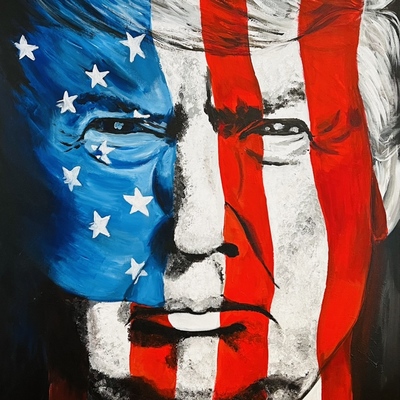Stay informed on the latest Truth Social posts from Donald Trump (@realDonaldTrump) without the doomscrolling. Consider it a public service for your mental health. (Why?)
- Trump's tariff revenues are hitting record-highs.
- Tariff revenues topped $113 billion for the first time during the fiscal year.
- The U.S. received more than $27 billion in customs duties in June.
- These figures are derived from the Treasury Department's 'Customs and Certain Excise Taxes' data.
- President Donald Trump imposes near-weekly duties on some of the world’s largest economies.
The post emphasizes record-high tariff revenues, indicating the continued and effective application of trade duties. This reinforces the narrative of sustained protectionist policies, which can impact global supply chains, corporate earnings (especially for multinational companies and importers), and overall economic growth expectations. While existing tariffs are generally priced in, continued emphasis on their success could signal an unchanging or potentially expanding policy stance, leading to moderate, ongoing re-evaluation of sector performance and corporate guidance within the S&P 500.
The post highlights the imposition of tariffs as a policy that generates significant revenue, implying an ongoing 'trade war' approach with major economies. While this creates economic friction and competition between nations, it does not inherently indicate a direct threat of military conflict escalation or an ultimatum. The focus is on the financial outcome of trade policies rather than explicit security threats.
- Commodities: Trade tensions, even when framed as revenue-generating, generally introduce uncertainty that can boost safe-haven assets like Gold (XAU). Industrial commodities like Copper may face headwinds due to potential global growth slowdowns caused by trade friction. Oil (WTI) could see demand pressure from a less interconnected global economy. Short-Term Watchlist: XAU/USD price action for safe-haven flows; oil inventory reports for demand implications. Medium-Term Focus: Inflation trends (tariffs can be inflationary), global growth forecasts affecting industrial demand.
- Currencies (Forex): The US Dollar Index (DXY) could see mixed reactions; while tariffs generate revenue for the U.S. treasury, the underlying 'trade war' can create global economic uncertainty, potentially driving safe-haven flows into the USD, or conversely, raise concerns about global trade volumes. Currencies of countries targeted by tariffs (e.g., CNY, EUR) may face depreciation pressure. Short-Term Watchlist: US Treasury yields affecting interest rate differentials; global risk sentiment influencing safe-haven demand. Medium-Term Focus: Central bank policy divergence in response to trade impacts; global trade balance figures.
- Global Equities: Tariffs, while generating revenue, can increase costs for companies with international supply chains and may reduce global trade volumes, generally viewed as a negative for overall corporate profits. Markets like the S&P 500 might see sector rotation, with domestic-focused industries potentially outperforming multinational exporters. European (STOXX 600) and Asian (Nikkei 225, Hang Seng) equities may face particular headwinds if their economies are heavily export-dependent or targeted by duties. Short-Term Watchlist: Futures market reactions; performance of sectors sensitive to trade (e.g., semiconductors, autos). Medium-Term Focus: Company earnings revisions reflecting tariff impacts; macro-economic indicators like manufacturing PMIs.
- Fixed Income (Bonds): Increased trade tensions typically lead to a flight to safety, driving demand for U.S. Treasuries and potentially pushing yields (US 10Y, 2Y) lower. However, if tariffs are perceived as inflationary, longer-term yields could eventually rise. Credit spreads may widen for companies or sovereign entities heavily exposed to trade policy changes. Short-Term Watchlist: US Treasury yield curve movements (flattening could indicate risk aversion); credit default swap spreads. Medium-Term Focus: Fiscal policy debates, especially if tariff revenues are presented as a solution to budget deficits; central bank responses to inflation or growth concerns.
- Volatility / Derivatives: The continued application of tariffs and the 'trade war' rhetoric can sustain elevated market uncertainty, which would likely support higher levels for the VIX (volatility index). Options positioning might reflect increased demand for downside protection or speculative bets on market swings. Short-Term Watchlist: VIX levels and its term structure for signs of market fear; implied volatility across major indices. Medium-Term Focus: Shifts in the overall market volatility regime; impact of policy uncertainty on investor risk appetite.
- Crypto / Digital Assets: Bitcoin (BTC) and other digital assets often exhibit correlation with broader risk assets like tech stocks. Sustained trade tensions and global economic uncertainty could lead to a 'risk-off' environment, potentially causing downward pressure on crypto assets, or alternatively, a narrative of digital assets as an alternative hedge against traditional financial system instability may emerge, though less common in this specific context. Short-Term Watchlist: BTC/USD price action relative to equity markets; funding rates on derivatives exchanges. Medium-Term Focus: Macro liquidity conditions; regulatory developments surrounding digital asset markets.
- Cross-Asset Correlations and Systemic Risk: Prolonged trade friction can lead to unusual correlations, such as equities and bonds moving in the same direction (both falling) if fears of stagflation or systemic economic slowdown intensify. Potential for liquidity stress in specific sectors or regions heavily reliant on global trade could increase. Short-Term Watchlist: MOVE index for bond market volatility; corporate credit spreads for signs of stress; co-movement of traditional safe-havens like Gold and the USD. Medium-Term Focus: Central bank responses to global trade shocks; potential for supply chain disruptions to cascade through the economy.
- Retail Sentiment / Market Psychology: The post's narrative of record tariff revenues and a triumphant stance could resonate positively with retail investors who support the 'America First' economic agenda. It may foster a belief in the efficacy of protectionist policies. While unlikely to directly trigger meme stock frenzies, it could influence overall sentiment towards domestic economic strength versus global integration. Short-Term Watchlist: Social media discussions regarding trade policies; retail trading platform activity. Medium-Term Focus: How political narratives shape retail investment trends; the influence of populist economic policies on market participation.

